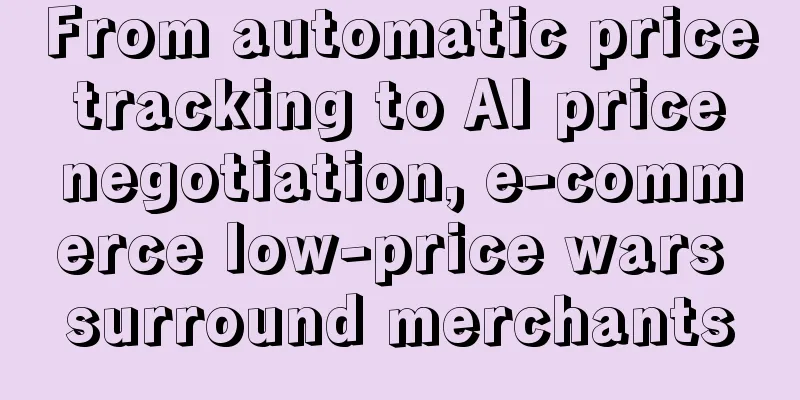E-commerce image and product testing: What to do if the link has bad data?

Those who do e-commerce should all know about image and model testing. If you still can’t make money in e-commerce, it is probably because you don’t know what image and model testing is, or you know it but have never done it. The purpose of testing images and products is to find out the links that can be used, that is, the links with growth potential, and then focus all the advertising budget on this link. In this way, no matter how much money you lose, even if it is 200,000 or 300,000, you will eventually make it back. This is the value of testing images and products. I understand the principle of testing pictures and models, but when I actually implement it, I find that things are far from as simple as I imagined. The first problem is that I put 10 links to test at once, but none of them worked. I started to think, if none of them worked, is it because my product is not good enough? Is it because of my internal strength? Or is it because of my bad luck? If I have a question, I must find the correct answer. This answer determines my next move. If the product is not good, then I will give up on it. If it is because of my internal strength, then I will make a few more pictures to test it. If it is because of my bad luck and I cannot attract the crowd, then I will test it for a few more days. Since there is not much data available on the platform, we only know that the linked data is not good, but it is difficult to tell the specific reason. 1. Directly abandon the link with bad dataThis is the approach I have advocated before. Link testing is to test the links that can be hit. Since the data is not good, why keep it? Giving up is the best solution. The adoption of this strategy also varies from person to person. First of all, you must have a strong ability to output materials, at least be able to output a set of materials every day (original main picture SKU picture). In this way, if you put one link up for testing every day, you can test about 30 links in a month. No matter they are the same or different models, the probability of 1~2 links running out of 30 links is still quite high. Put products on the shelves in batches, test them in batches, discard them if they don’t work, and continue putting them on the shelves in batches, just like the waves washing away the sand. Another advantage of this strategy is that it can be standardized. I was leading a new person who had no experience in e-commerce operations. Following this process, he was able to generate links with daily sales of over 5K in two weeks. Do you think this person was lucky? Or had a strong learning ability? Neither. It was the right strategy. Without screening dozens of links a month, how could he have found links that worked? If you choose this link testing method, you must be prepared to work overtime. I have said before that e-commerce is actually a physical job, which is reflected here. It doesn't matter if you have five or six years of e-commerce operation experience or five or six days of experience. As long as you can upload at least one original material link every day, you can definitely set up a store with daily sales of 3K in 3 months. As the driving function of the platform becomes simpler, new link driving can just bid to break even. What is the difference between a new driver and an experienced driver? Now that keywords cannot be used, the technical gap between everyone is gradually narrowed. Therefore, whoever can post more links every day and quickly test more links that can be hit can make money in e-commerce. 2. Continue to optimize links with poor dataThe above is a standardized link testing process, but what I am going to talk about next is not so standard. Why? Because I once selected 3 brands, made 3 original links for each brand, and tried them all at once, but none of them worked. You know, these nearly 10 sets of original materials took me a lot of time. If I give up directly according to the previous operation ideas, I would still be unwilling to do so. After all, they are my hard work and cannot be wasted like this. I should be able to save them. So I started the second way of testing pictures and models, saving spam links. How to save them? Of course, I optimized them through data. I have 3 products and 9 links. The data of through trains are also different. Some have high clicks but no conversions; some have no clicks and no conversions; some have no clicks, but occasionally there are orders. Therefore, for links that do not attract clicks, replace the main image, or directly put the main image of the link that is clicked into the cart image of this link; for links that do not convert well, report million-dollar hot items or big promotions to see if the conversion rate can be increased; for links that do not meet all the data, directly increase the ad bid to see if hard work can work a miracle. Saving spam links is not as physically demanding as continuously updating them, but it is mentally demanding. Based on past experience, if the test data of a link through train is not good, it can basically be judged that it has not hit the target audience. Such a link is labeled as junk and defective at birth. Saving the link means changing this label, which is very difficult. The most difficult part is actually the uncertainty. Unlike testing with a batch of links, I can estimate how long it will take to test a link that works. But when it comes to saving spam links, there is no predictability. It is hard to say that if I change a main picture or optimize the SKU, the link data will go up. The reason why I still do this despite such a high risk is that I don’t want to waste my efforts and bury potential links. Let me talk about the results of this strategy. After a long period of uninterrupted optimization, 9 links finally ran out of 1 link. My conclusion is: Generally, if I go to add new links at this time, I can probably test out 1 link that runs well. Judging from the results, abandoning links with poor data and optimizing spam links have the same results. The only difference is the path. Which method to choose depends on your specific situation. 3. FinallyThe links that I worked so hard to create were not accepted by the market, which really hit our confidence in e-commerce operations. However, the cost of making links is much lower than the cost of developing products. Who doesn't invest hundreds of thousands of dollars in the development of new products? Once the product is released, if buyers don't buy it, the loss will be huge. When we operate e-commerce and make links, if the data is not good, we can create new links, and the loss is very small. As for whether to discard or save the links that are tested to be bad, I think it depends on your heart and your experience. I think subjective judgment is more reference than data analysis. What do you think? Author: Tiger Talks Operations Source: Tiger Talk Operations "(ID: laohujiangyy)" |
>>: Weibo AI is "far ahead" in terms of venomous tongue in the comment section
Recommend
How to follow-sell all the products in Amazon? How to follow-sell in bulk?
If Amazon merchants want to copy-sell other mercha...
E-commerce platforms have launched "automatic price tracking" one after another, forcing hundreds of millions of merchants to hurry up
During this particularly difficult 618, merchants ...
The reasons and solutions for the second phase of the interruption of Pinduoduo's through train
"What is the solution to the interruption of ...
Get ready for Double Eleven! 7 live streaming sales tactics to use right now!
Double Eleven is around the corner, and it’s time ...
2024 Spring Festival Homecoming, Xiaohongshu Sponsoring Spring Festival Gala, Competition in the Milk Tea Industry
The Spring Festival has passed. During your return...
Order Luckin Coffee on JD.com, and Meituan will cry for it
JD.com recently launched a new service that allows...
"Freeloading" has become the first choice for marketing
In this fast-paced era, Internet people are chasin...
In order to find out the secrets in the phones of old babies, I studied 100 middle-aged and elderly TikTok accounts
What types of content do middle-aged and elderly u...
What are the categories of cross-border e-commerce? What does cross-border e-commerce do?
With the advancement of globalization, cross-borde...
How to check the traffic of Amazon store? How to check it?
If you are running an Amazon store, you are actual...
Growth Talk: North Star Indicator
The North Star Metric (NSM) plays an important rol...
Is it easy to do business on Amazon now? How does Amazon do it?
In recent years, domestic e-commerce competition h...
How to recover a stolen Shopee store? What to do if the account is frozen?
If the Shopee account is set up too simply, the st...
Is it profitable to open a store on Shopee? What is the process of opening a store?
It is still very common for individuals to open st...
Beware! Eight common misunderstandings in learning data analysis
Data analysis is a popular skill that attracts man...









